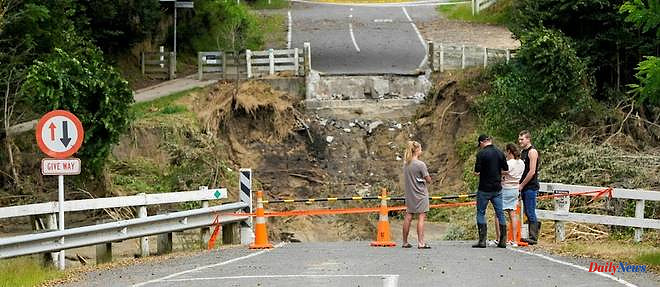After the passage of cyclone Gabrielle in New Zealand, priority for isolated areas: the authorities, overwhelmed, deployed the army on Thursday to deliver water, food and fuel, and finally accepted offers of aid from abroad.
Prime Minister Chris Hipkins has warned that it will take a long time to erase the traces of Cyclone Gabrielle which hit the north of the country on Monday, killing five and 10,500 displaced following torrential rains.
Police say around 3,500 people have been listed as "unreachable", with residents desperately trying to reach loved ones.
More deaths are feared, warned Mr Hipkins, who said more than 100,000 homes were still without power on the North Island, home to more than three-quarters of the country's five million people.
"It's a traumatic event," said the leader on Thursday. "It is a very big challenge to restore the infrastructure as quickly as possible, we must recognize that we are facing a long way of the cross".
"There is no miracle solution. We could make the bulldozers work 24 hours a day, 7 days a week, it would still take time to restore road links," he argued.
The government said it has deployed two warships and a C-130 Hercules transport plane to deliver thousands of liters of water, personnel and several mobile water treatment devices to hard-hit areas.
NH90 helicopters were also sent, particularly to the Hawke's Bay region (north-east), the most affected, where they rescued workers, families or pets perched on roofs to escape the rising waters.
Faced with the magnitude of the task, Chris Hipkins also indicated that he finally accepted offers of international aid, after initially rejecting them.
On Thursday, the town of Napier, in Hawkes Bay, was cut off from the world after damage was found on the last bridge connecting its 65,000 inhabitants to the rest of the country. The bridge is now passable, said the national transport agency, but only for rescuers.
Across the city, petrol stations have put up signs saying "no fuel", except for emergency services, an AFP journalist noted.
Residents have been ordered not to leave their homes unless absolutely necessary, and to limit their water consumption.
And when they venture outside, they have to wade through murky floodwaters to refuel or search for an internet connection.
The region, with once bucolic landscapes, is unrecognizable, between impetuous torrents, destroyed roads and major landslides.
For four days, high winds and downpours caused flooding and landslides, washing away roads and cutting communications across the North Island.
Cyclone Gabrielle formed on February 8 off the northeast coast of Australia in the Coral Sea. Further rain is expected on Thursday, complicating rescue and rehabilitation efforts in affected areas.
According to scientists, the cyclone was exacerbated by exceptionally warm seas, under the combined effect of climate change and the La Nina phenomenon.
02/16/2023 09:23:43 - Napier (New Zealand) (AFP) - © 2023 AFP












